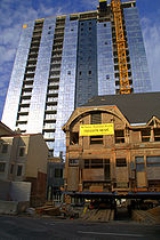
Ladd Tower
Encyclopedia
Ladd Tower is a 23-story residential building in Portland, Oregon
completed in early 2009. The construction of Ladd Tower caused the Ladd Carriage House
to be moved from its foundation, returning in October 2008. Holland Residential manages the building, which also has commercial space on the ground floor. The main residential tower also shares space on the first through third floors with a church next door.
The tower is Leadership in Energy and Environmental Design
-certified.
The tower was originally slated to sell as condominiums. Only 60 of 200 units were presold. In 2007, Opus Northwest converted the project to rental apartments, returning deposits to approximately 60 buyers. The building was redesigned, with shorter ceilings, leaving the overall building height unchanged, but going from 21 to 23 floors. The apartments were smaller, at 343 apartments, versus 189 condos in the original plan.
The original design of the tower put the building flush against the South Park Blocks
. A 27-foot setback beginning at the fourth story caused "unanimous approval from the Portland Design Commission, a dramatic turnaround from icy receptions to two
earlier proposals" according to The Oregonian
. A local developer called it a "low-ego building".
The building is named after early local politician and developer William S. Ladd
.
Portland, Oregon
Portland is a city located in the Pacific Northwest, near the confluence of the Willamette and Columbia rivers in the U.S. state of Oregon. As of the 2010 Census, it had a population of 583,776, making it the 29th most populous city in the United States...
completed in early 2009. The construction of Ladd Tower caused the Ladd Carriage House
Ladd Carriage House
The Ladd Carriage House is a building in downtown Portland, Oregon. It is one of the few surviving pieces of the former grand estates which once existed in the downtown core. It was on the National Register of Historic Places from 1980 until 2008. It was restored to the listing in 2010.The building...
to be moved from its foundation, returning in October 2008. Holland Residential manages the building, which also has commercial space on the ground floor. The main residential tower also shares space on the first through third floors with a church next door.
The tower is Leadership in Energy and Environmental Design
Leadership in Energy and Environmental Design
Leadership in Energy and Environmental Design consists of a suite of rating systems for the design, construction and operation of high performance green buildings, homes and neighborhoods....
-certified.
The tower was originally slated to sell as condominiums. Only 60 of 200 units were presold. In 2007, Opus Northwest converted the project to rental apartments, returning deposits to approximately 60 buyers. The building was redesigned, with shorter ceilings, leaving the overall building height unchanged, but going from 21 to 23 floors. The apartments were smaller, at 343 apartments, versus 189 condos in the original plan.
The original design of the tower put the building flush against the South Park Blocks
South Park Blocks
The South Park Blocks form a city park in downtown Portland, Oregon. The Oregonian has called it Portland's "extended family room", as Pioneer Courthouse Square is known as Portland's "living room"....
. A 27-foot setback beginning at the fourth story caused "unanimous approval from the Portland Design Commission, a dramatic turnaround from icy receptions to two
earlier proposals" according to The Oregonian
The Oregonian
The Oregonian is the major daily newspaper in Portland, Oregon, owned by Advance Publications. It is the oldest continuously published newspaper on the U.S. west coast, founded as a weekly by Thomas J. Dryer on December 4, 1850...
. A local developer called it a "low-ego building".
The building is named after early local politician and developer William S. Ladd
William S. Ladd
William Sargent Ladd was an American politician and businessman in Oregon. He twice served as Portland, Oregon’s mayor in the 1850s. A native of Vermont, he was a prominent figure in the early development of Portland, and co-founded the first bank in the state in 1859...
.

